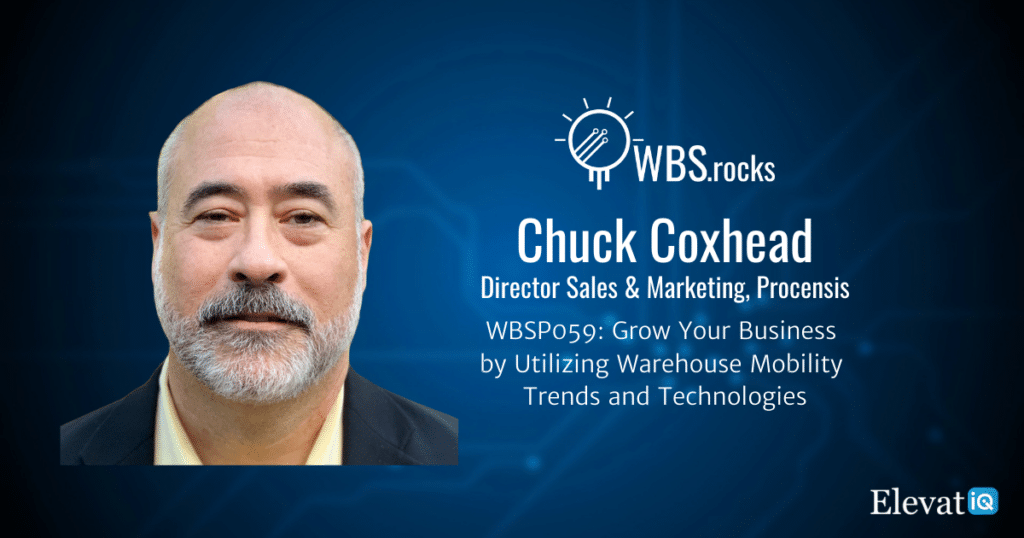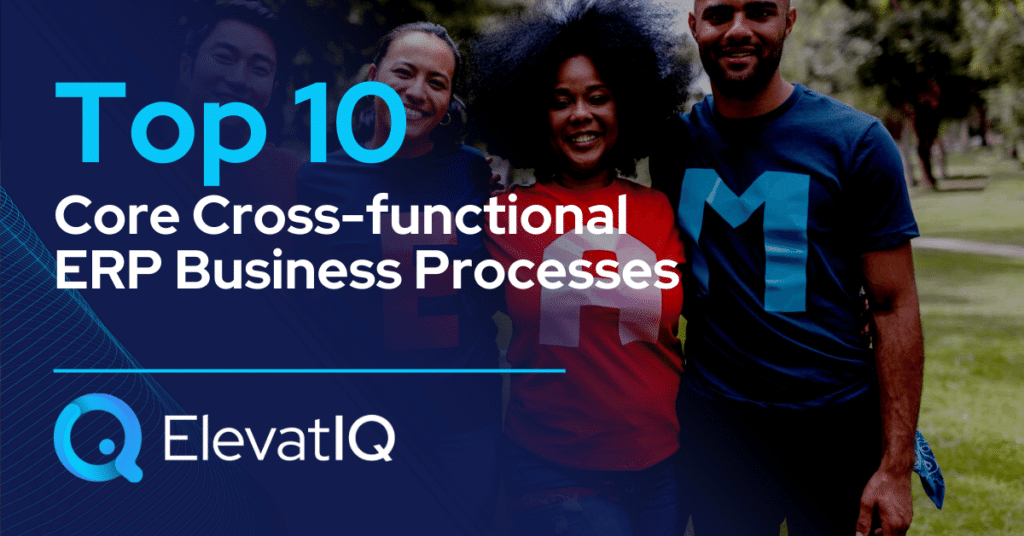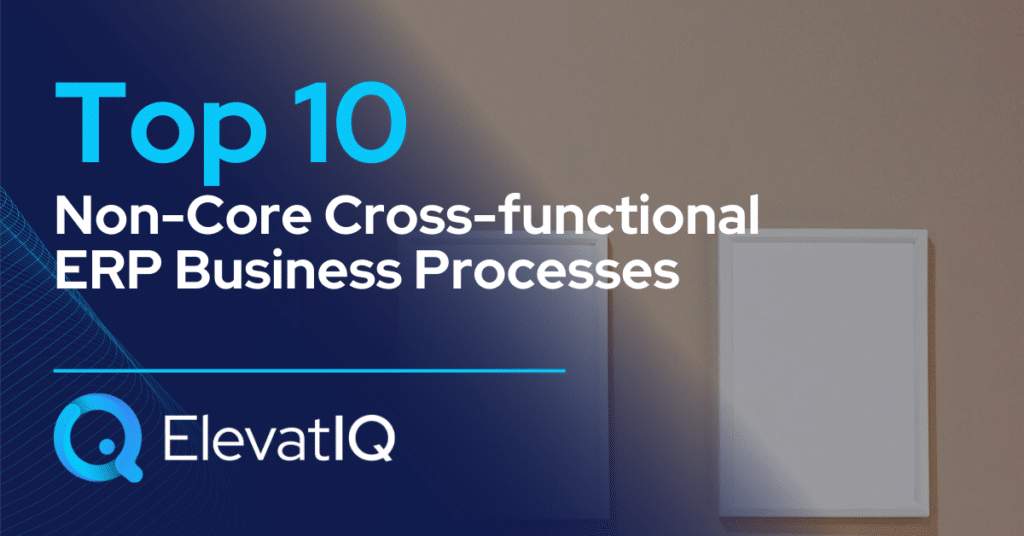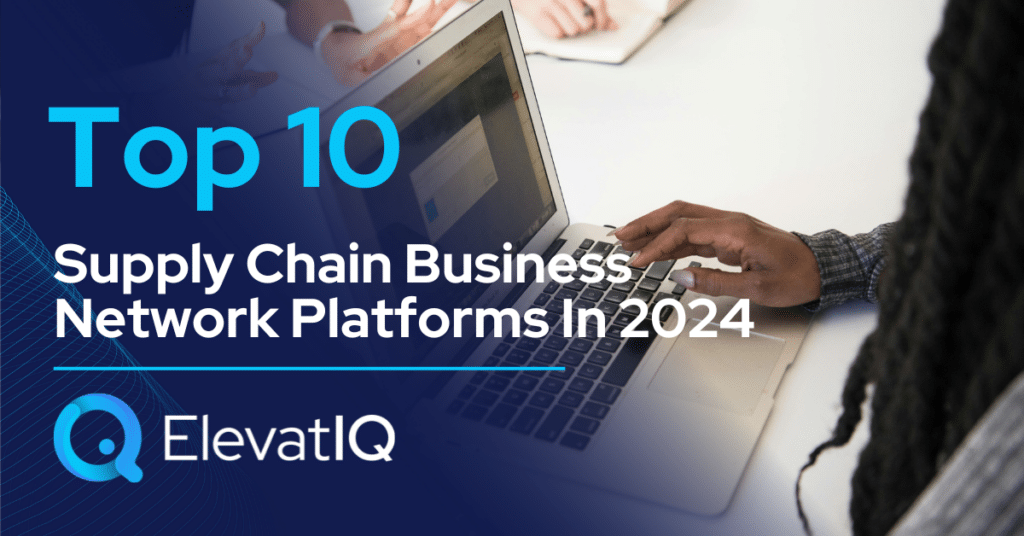In this episode, we have our guest Chuck Coxhead from Procensis, who discusses warehouse mobility trends in the enterprise and SMB markets. He also describes technical details of several warehouse mobility technologies along with crossover between ERP and WMS systems. Finally, he has had a chance to touch on how manufacturers can evaluate mobility technologies and take advantage of the new trends such as Micro-fulfilment.
Chapter Markers
- [0:22] Intro
- [2:40] Personal journey and current focus
- [3:42] Perspective on growth
- [4:54] Warehouse mobility trends
- [7:26] Operational efficiency gains due to warehouse mobility
- [15:32] Warehouse mobility system architecture for SMBs
- [18:43] The role of industrial browsers for warehouse mobility
- [20:22] Pre-requisites and business process redesign for warehouse mobility journey
- [25:30] How warehouse mobility needs differ across industries
- [30:13] Micro-fulfillment
- [33:20] Closing thoughts
- [34:30] Outro
Key Takeaways
- They can’t afford to carry products and travelers across the floor to get to terminals. They need to go mobile and bring it to the worker while manufacturing is done with their hands. So folks need to be hands-free whenever possible. So the ergonomics becomes tremendous.
- Some of the self-hosted systems do operate in a browser, but many of them don’t. So the mobile technology really has to be able to address all of the different ERP and WMS systems.
- If you lose connectivity at your house, your video might hiccup if you happen to be watching videos, but if you’re doing that in an enterprise, and you’re doing that mid-transaction, well, you’re gonna have a problem.
- Where you have everything from small products, to large products, to large boxes, medium boxes, and everything in between, the kind of agility you derive from hands-free picking where everything is wearable is incredible.
- If you have a lot of different parts and if those parts are very small and you need dexterity, then a full wearable solution clearly makes the most sense.
- Those retailers can improve and increase their inventory level, and they can increase the diversity of their inventory and product availability, and that inventory is co-located or stored closer to the point of delivery in the point of use. So this micro fulfillment is an incredible trend.

Subscribe and Review
Apple | Spotify | Stitcher | Google Podcasts | Deezer | Player FM | Castbox
About Chuck
With over 30 years of experience in manufacturing companies, Chuck Coxhead has worked in all parts of the organization from the shop floor to Engineering, to Sales & Marketing, Operations, HR, IT, Supply Chain, and Warehouse. Chuck brings a unique cross-functional perspective to continuous improvement that began with his education and work as an Industrial Engineer and crossing over into numerous multi-million dollar Sales wins and business turn-around success stories.
Resources
Full Transcript
Chuck Coxhead 0:00
The pet food store right around the corner has about five different locations, and they’ve always maintained a reasonably large inventory. But how are they going to compete with Amazon and Chewy? Well, they have to significantly improve their inventory. And by the way, the cost of having a delivery service is a huge test to branch out. They never really did it.
Intro 0:22
Growing a business requires a holistic approach that extends beyond sales and marketing. This approach needs alignment among people, processes, and technologies. So if you’re a business owner, operations, or finance leader looking to learn growth strategies from your peers and competitors, you’re tuned into the right podcast. Welcome to the WBS podcast, where scalable growth using business systems is our number one priority. Now, here is your host, Sam Gupta.
Sam Gupta 0:59
Hey everyone, welcome back to another episode of the WBS podcast. I’m Sam Gupta, your host, and principal consultant at a digital transformation consulting firm, ElevatIQ.
Warehouse mobility can increase the efficiency significantly of your warehouse, from automating your data entry to voice-enabled begging but how to plan for a warehouse mobility journey. Is it as simple as picking a bunch of barcode readers from the market and be mobile? Or do companies need to plan based on the size of the warehouse ergonomics?
In today’s episode, we have our guest Chuck Coxhead from Procensis, who discusses warehouse mobility trends in the enterprise and SME market. He also describes technical details of several warehouse mobility technologies along with a crossover between ERP and WMS systems. Finally, he has had a chance to touch on how manufacturers can evaluate warehouse mobility technologies and take advantage of the new trends such as micro fulfillment.
Let me introduce Chuck to you.
With over 30 years of experience in manufacturing companies, Chuck Coxhead has worked in all parts of the organization, from the shop floor to engineering to sales and marketing operations, HR and Supply Chain, and warehouse. Chuck brings a unique cross-functional perspective to continuous improvement that begins with his education and works as an industrial engineer and crosses over into numerous multibillion-dollar sales wins.
With that, let’s get to the conversation.
Hey, Chuck, welcome to the show.
Hey, Sam.
Chuck Coxhead 2:37
It’s so good to see you.
Sam Gupta 2:40
Of course, so just to kick things off, do you want to start with your personal story and current focus?
Chuck Coxhead 2:45
Yeah, sure, so I’m a 30 plus year manufacturing professional. I started out studying Industrial Engineering at Lehigh University. And I assume just about every role in a manufacturing organization that you can. I’ve been a CNC programmer, I’ve worked on the shop floor. I’ve worked in warehouse-driven forklifts. And I’ve been responsible for engineering, product design, operations, purchasing, finance inventory planning, but I’ve spent an awful lot of my time in sales and marketing, which has really been the focus of my career for the past 20 years.
So currently, I’m working for Procensis. And we’re really focused on mobilizing MRP and warehouse management systems for warehouse and distribution centers. There’s tremendous growth in e-commerce and warehousing distribution. And there’s just an incredible push to improve productivity, decrease the time it takes to do mundane data entry, and also improve accuracy because on the other end of a missed package or miss shipment is a very unhappy customer.
Sam Gupta 3:42
Yep. And we are going to dig into all of that. But before we do that, there is one standard question that we ask all of our guests, and that is going to be your perspective on growth. So Chuck, when you think of growth, what does it mean to you?
Chuck Coxhead 3:54
Honestly, Sam, I think growth is a double-edged sword. Yeah, it cuts both ways. Clearly, there are so many folks out there who fantasize about hockey stick growth, and there are those who are content with just being flat and being fat, dumb, and happy.
But honestly, it’s really more about can your growth match your business model. If the growth far outstrips your business model, the only thing you’re going to lose is loyal customers. The only thing that’s going to happen is you’re going to end up being dissatisfied yourself, your employees will be dissatisfied, and most importantly, your customers will be dissatisfied.
So it’s really important to understand who you are, what you can really do, and then grow accordingly. Now, if you want hockey stick growth, adjust your business model, but if it’s healthy, organic growth that you can conquer in a very manageable fashion without terribly affecting your employees and your customers because, after all, the biggest challenge any organizations change management well then that’s really what you want to target is you want to target a nice healthy realistic growth.
Sam Gupta 4:54
Okay, amazing. So obviously, we are going to be talking about now mobilizing the warehouse distribution centers. And we are going to be looking at what trends you are seeing at this point in time in the market?
Are you satisfied with the manufacturers that you are working with? Do they have enough mobilization in their warehouses? Do they have enough automation in the warehouses? And let’s say if you were the manufacturing executive, what would you change in those warehouses?
Chuck Coxhead 5:26
Well, it’s really interesting, the trends, we all know it’s really made it to the mainstream, and it’s made it to Facebook. Supply Chain is everything. Supply Chain has always been incredibly important. But it really took a pandemic, sadly, to make the supply chain cool. And to amplify the importance of it. Well, the universities got a head start on this year ago. I’m an industrial engineer. I studied almost 35 years ago or thereabouts.
They added a supply chain aspect of the industrial systems engineering curriculum years ago. The business departments have added supply chain specialization, so they were way ahead of the curve, and they really knew what was going on. Well, now the rest of the world knows, and the e-commerce explosion and the delivery problems that we’re seeing will; this is all the new normal, we can expect to see this forever.
And that is fueling a tremendous shift toward productivity in manufacturing warehouses and distribution centers. There’s an eye like there’s never been coupled with that the technology for it has for warehouse mobility for robotics, for AI, these things have all reached a critical point in their development where they are becoming more and more realistic to deploy to places that never would have considered it before.
Chuck Coxhead 6:40
There are people that are working on an old paper for their data entry and just keep punching that is really considering technology solutions for the first time. So there’s really this amazing confluence that’s going on right now.
And there are also a number of other things going on. There are improvements in MRP. And warehouse management systems. There are major upgrades in ERP and warehouse management systems. And one of the other things we’re seeing is that some of the customers deploy technology quite some time ago.
But now it’s time for the next upgrade. It’s time for the next iteration. And this confluence is happening all at the same time. We see these things in the grocery store from people picking orders for grocery delivery and e-commerce. We never saw anything like that. But it’s all happening exactly at the same time.
Sam Gupta 7:26
Okay, amazing. So let’s talk about some stories. Do you have any stories by any chance of the customers where let’s say, you might be engaged with where you have made some changes in the warehouse? And because of that, they could grow significantly? Do you have any stories that you might be able to share?
Chuck Coxhead 7:40
This is kind of crazy; I’m actually going to start out with a story that’s kind of just the opposite. It’s a story about a president who was very frustrated with his own company. And in his own words, he says, We stink at implementing technology.
Chuck Coxhead 8:00
This is a real thing. And his ERP system was three versions behind. He had no intention of updating it. He hadn’t even updated it for security. Yeah. And he was doing all of this data entry and keypunching, and he didn’t realize that you need to take the next level and technology implementation in order to get rid of all that non-productive time in order to get more out of the same people that you have.
I don’t like to say more with less; I like to say more with the same. And I think that is all too prevalent. I’ve worked with other customers, and oftentimes it is.
Chuck Coxhead 8:35
So I like the word you use, lifestyle business. Oftentimes some of the lifestyle companies where they don’t really fully understand the benefits of the technology to continuous improvement. Now we’re coming across customers right now that are engaging in significant updates to the WMS system.
There are major version changes that have happened out there. And these things happen once a decade. And so we’re seeing a lot of folks that are doing that right now. We’ve taken these folks, and they’re having accuracy problems, big time, where they’re having 10% of their scans, 5% of their scans, or their pics are a problem.
Well, that just results in these things being done all over again. So I’m not allowed to name the names. But we’ve literally taken some of these warehousing operations. And we’ve improved their accuracy from 85-90-95% up to 97-98-99% within days.
Chuck Coxhead 9:31
And our focus is putting wearables, and it’s on putting mobile computing, and whether it be handheld or vehicle-mounted barcode scanners, into the hands of workers so that they can be hands-free so that they can be more mobile and the time savings on that we’ve done time studies on this and you can literally see a video on my website where we’ve saved 20% in one example.
There are time studies where people are saving 30%. 30% in their scan time because they’re hands-free. And now these are household brand names, ecommerce companies that you have bought from that everybody listening knows these brands, and they’re making these moves.
Now they have a lot to consider. We’re up against robotics. Robotics is cool. They’re also the stuff of sci-fi movies. Some of them aren’t all that happy. Some of them are, but they have a lot to consider. Now, we have worked with some of the largest companies in the country, and they’re all telling us the same thing. We really want to work with our people. We’re more interested in human intelligence than artificial intelligence now. Are there some people that are some companies that go that way?
Chuck Coxhead 10:41
Absolutely. And their business models and their operations are designed for it. And I encourage it, but it’s not for everyone. And these customers, they see this, they see the ability to wear a mobile computer on their arm, they see the ability to mount a scanner to the back of their hand, they see the ability to shoot barcodes from 15 to 30 feet away without the mounting or dismounting the forklift.
These are all real applications, real stories where these warehouses are realizing these amazing improvements overnight. Then we have a customer doorman products. They’re located in Pennsylvania. And this customer gave us a testimonial where these technologies, and this is a testament to human intelligence versus AI.
They got the product up and running in 15 minutes, where other solutions would have taken hours or days, literally, because of the solution that we provide. The solution is not just mobile computing and wearable scanning. The solution is also customized user interfaces that are working right in with the ERP and warehouse management systems to make them intuitive, easy to use, wearable with a usable with gloves if you’re in a cold storage environment. So all these things are real technologies that are happening today. And we’re just honestly just having so much fun.
Sam Gupta 11:58
Okay, amazing. So obviously, when we talk about the bigger companies, they have a lot of money. They have a lot of investments that they can make. And obviously, I don’t know if you’re seeing similar trends in these small to medium-sized businesses as well. So when we look at the landscape of the small to medium-sized businesses, at least in our experience, they are probably going to have just one ERP system, and they might have the barcode scanning.
That’s a match that we have seen. So what are some of the trends that you see in the SMB market? Do you have any stories from the SMB market where the manufacturers or the distributors, or the e-commerce players have had significant efficiency gains because of the warehouse improvements?
Chuck Coxhead 12:36
So in small-medium businesses, the gains are typically potentially greater as a percentage of the time because the small and medium businesses are maybe using old, outdated tech, or they may have never used these things in the past. And, for instance, in manufacturing, I have implemented entire inventory management systems, I have implemented cycle counting, and all of these different things myself.
Yeah, I’ve put in inventory planning and implementing an ERP system or two. And what they’re seeing is these improvements in material handling that they never had before. The manufacturers, for instance, there’s actually also there were computing resources on the floor because some of the manufacturers have extensive documentation and plans that are on the floor for their folks to see, for instance, a machine shop or an assembly shop or something to that effect, or they may have compliance documentation that they need to complete in the process.
Chuck Coxhead 13:37
So they have computing resources on the floor, but they’re still stuck with this data entry task of tracking time, traceability of materials, all of these things, that can take a tremendous amount of time, heck, receiving material can take an awful lot of time for this data entry. So that alone in the manufacturing space is tremendous. I had a fella one time who tried to sell me a product for tracking, and he wanted to pin it onto my ERP system.
And what he told me was, well, it’s only going to be 30 seconds of additional time. 30 seconds. It’s not that big a deal, right? Yeah, except that my total cycle time for this product was two minutes, he was adding a full 25% additional time to my processing. Yeah, by implementing his solution, all that so that I could get more data for planning, which is wonderful. The data is incredible. And what’s been done with data structures and planning and forecasting, and that sort of thing is just the strides have been tremendous, but that barcode or the barcode reading and the time tracking and all of that is such a tremendous part of the process that they’ve got to knock that out.
Chuck Coxhead 14:42
They just have to knock it out, and they can’t afford to carry products and travelers across the floor to get to terminals. They need to go mobile. They need to bring it to the worker while manufacturing is done with their hands. So folks need to be hands-free whenever possible.
So the ergonomics becomes tremendous. There are also distractions. You’re in a manufacturing environment. You’re distracted. You’re injured. So low distraction is really, really crucial. And the small and medium businesses, it’s even more so because their volumes are low. So their profit margins are potentially lower depending on the market they’re in because they don’t have the benefit of volume and a tremendous investment in process improvement.
So in these businesses, I’m thinking about manufacturing. From my history, these improvements are just crucial, honestly, just crucial if they want to continue to compete.
Sam Gupta 15:32
Okay, so let’s talk about the overall system landscape of small to medium-sized businesses that you are working with. So I don’t know if they are always going to have a WMS application. And sometimes, there is always a crossover between a WMS and ERP. And then they have e-commerce as well.
So in your experience, are these systems always connected? Would connectivity be a problem for any of the mobile solutions that these manufacturers might be thinking of utilizing? So how does the integration work between, let’s say, your mobile device, and then the WMS system and then ERP? And then they might have e-commerce as well.
Chuck Coxhead 16:10
So separate WMS is clearly going to be for an organization that has a significant movement of product within warehousing distribution, but for small, medium businesses, and I confess a lot of our customers are medium and large businesses. But I have a tremendous amount of experience in small and medium businesses for 30 years.
And most of those folks are going to have one system as opposed to a system that may consist of multiple parts that are integrated together. They’re really going to be one. So in terms of connectivity, there’s a big push to cloud computing. But there are still systems out there that are hosted, inside that, although some of those self-hosted systems do operate in a browser, okay, but many of them don’t. So the mobile technology really has to be able to address all of the different ERP and WMS systems.
Chuck Coxhead 17:03
And that’s done in a couple of ways. We’re all of the browser-based systems, whether it be self-hosted or whether it be a cloud-based system. That’s really done with an industrial browser. This is not the kind of stuff that is done with Chrome browsers. Consumer browsers operate asymmetrically, where data entry is a really critical order of operation and things like that, as well as connectivity.
If you lose connectivity at your house and your camera, your browser, and you’re on Facebook, no harm, no foul, your video might hiccup if you happen to be watching videos, okay, but if you’re doing that in an enterprise, and you’re doing that mid-transaction, well, you’re gonna have a problem.
So that really requires an industrial browser, the cool part about the industrial browsers, and in our case, we’re working with Ivanti with their velocity industrial browser product. These allow both browser HTML sessions, and they also allow Telnet sessions.
Chuck Coxhead 17:53
Telnet is not the kind of thing that is used out across the internet because it’s not a secure protocol. But it’s used inside for on-premises systems that aren’t using an HTML interface. So the mobile computers can connect with any system out there. And that is really what has required that kind of diversity of connectivity, that kind of diversity of interfaces required because we don’t know what system we’re going to come across.
I’m dealing with a HighJump customer. I’m dealing with an SAP EWM customer. I’m dealing with Infor customers. I was on the phone with a guy working with ProShop. I’ve worked with E2 from ShopTech. So there is a myriad of systems. I’m working with somebody on Sage as well. Every one of those things has different interfaces. You really have to be able to adapt. Any industrial browser takes care of that.
Sam Gupta 18:43
Okay, so tell us more about the industrial browser. And I’m not sure if I follow completely, and probably my audience is not very technical, right? So they are not going to understand this as well. So from their perspective, let’s say if they want to understand what industrial browser is and how it is going to impact them, can you tell me more about that?
Chuck Coxhead 19:03
So the industrial browser, while you go out and download it, you won’t get it to work. It’s not designed for you to be able to type in addresses and go out and visit your favorite website. Okay, it’s designed with a single purpose for single-minded connectivity to a server or an application.
And it’s configured as such. It does have all the same underlying engines that your commercial consumer browser does. It works with the same language. It works with the same basic, a Hypertext Markup Language, HTML, JavaScript, style sheets, all these different things.
It supports all of that, but it’s just simply not the same thing in that it’s made for robust and continuous connectivity. So we’re not even talking about the same Wi-Fi that you have in your house you’re talking about, where we’re blind spots can really cause a problem within your building.
So it’s there’s a big difference between industrial and consumer browsers. As I said, you can go out. Download it. I put it on my iPhone just because I could I wasn’t able to do anything with it. Because I had no system to which I could connect it technically.
Sam Gupta 20:07
Okay, so is it fair to say that it is probably used for the device to device communication? Is that a fair statement?
Chuck Coxhead 20:13
I would. Yes, it’s device-to-device communication, so many devices to one host, if you will, they’re all set up that way. But this one’s very special purpose-driven.
Sam Gupta 20:22
Yep. So let’s talk more about warehouse mobility. So let’s say if I have this small to the medium-sized manufacturer, and I’m probably the executive of a small manufacturing company. And obviously, I have some problems related to picking. I have problems related to accuracy.
And I’m actually trying to figure out if mobile computing can probably help me in that direction. So what would be your, let’s say, advice or recommendation for me in starting the journey on mobile computing? And what are the things that I need to get in order from the internal process perspective, from the system perspective, before I start the journey in mobile computing?
Chuck Coxhead 20:59
Well, the very first thing you need to do is just that you don’t understand your process. Oftentimes, that comes with a step-by-step breakdown of what the typical process is. So what does my picking entail? What does the data entry entail? What happens in the material handling when I do so? Okay, am I picking a pallet? Am I picking a case? Am I picking a piece?
Am I counting an inventory? Am I receiving all of those things that matter in your selection of what you’re trying to do? So, for instance, if I’m doing a pallet pick, I’m going to have a forklift more than likely or a pallet jack, which means that hands-free is not necessarily a big problem, because a lot of the time and it’s very important for me to drive the forklift safely, and not be distracted.
Chuck Coxhead 21:49
Likewise, I can actually scan from a distance those pallets rather than having to dismount the forklift. I can scan from the seat, okay, so that requires a different type of barcode scanner, one that is mid to long-range.
Now you can turn a mid-range bar scanner into a more long-range bar scanner with much bigger barcode labels. But realistically, you’re looking at a different scan engine. And that’s we represent Honeywell products, and their scan engine is amazing, their long-distance can be up to 30 feet.
So you can imagine sitting in a forklift, okay, and being able to scan something that’s 10 feet away without moving and then maneuver the forklift, pick it up and go. Now you could also be working with teeny tiny little pieces, okay, where hand dexterity could be an issue.
Chuck Coxhead 22:32
And in that case, you may want to do something that’s mounted to the back of your hand; we work with a company called ProGlove, which has one of the hottest scanners in the market. This allows completely hands-free scanning with full dexterity of your fingers, okay, and it’s actually a thumb press on the side of your hand to activate barcode scanning.
So it starts with really understanding what I am doing and what do I really need to accomplish in case I’m picking up boxes. So it can be a little tricky. If I have a handheld scanner and a handheld mobile computer, perhaps they’re integrated, but it’s tricky, and that it has a handle on it, okay, and I can drop it, or I have to set it down and pick up the case and then set the case down, then pick up the scanner and walk with the scanner, and then move. So it really helps to understand what it is you’re doing.
Chuck Coxhead 23:20
And there is a myriad of different choices. Now, these are all industrial products. Just as the browsers and industrial browsers, these are ruggedized products. We’re not talking about your iPhone, I love my iPhone, but it’s not a rugged product. These are products that if I do drop it, there’s no effect.
If I do get it a little wet, there’s no effect. And of the other things you need to consider is honestly safety. And one of the biggest things in safety is the pandemic. So are we sharing devices? Well, how do we treat them? What do we do with them? How do we disinfect them? So depending on your protocols, there are disinfection-ready devices.
I think you can imagine what it would be like if somebody came in with COVID. And everybody’s handling the same scanner. Well, that’s a real struggle. These devices are actually personalized. And indeed, they will assign someone at least by the shift, if not a device for each person, okay, a mobile computer with the amount on their arm, okay, or amount on their hand.
Chuck Coxhead 24:18
Now in these mounts, the mounts need to be washable, okay, or you need to have a lot of the mounts or the gloves that onto which they mount so that each one has each person has their own individual. So there are so many things to consider.
But honestly, it boils down to just a few choices, wearable versus handheld vehicle-mounted versus wearable mounted computer and scanner and then, of course, all the accessories that go along with them. One of the other things that you can integrate honestly is voice enablement. The system technology for European WMS has progressed to the point now where you just speak to it, and it speaks to you.
The voice recognition is tremendous. And it’s really agnostic to most people. So I mean, Someone says my English is my second language with the slang I have from the South Philly influence. But in general, it understands you. In general, it just understands you. So you say, four pieces got it to go, and off you go.
Once again, you’re using industrial headsets. It’s not your little earpiece you use for talking on your phone. So there are a lot of different things that you need to consider hands free safety, pallet, pick case, pick individual pick dexterity, all these different things. And then we make recommendations.
Sam Gupta 25:30
So yeah, so let’s make some recommendations here. Right, so let’s talk about some of the different industries that you are seeing in your experience. And let’s say the warehouse size that is also going to vary based on each of the sub-industry. For example, let’s say if I go to some of these high-volume ecommerce shops, maybe they have really large warehouses, and maybe they need specific types of scanners.
But when we go to, let’s say, some of the food and beverage ecommerce players, they might not have a large warehouse, and they might not even need the barcoding, or maybe they might not even need the scanning. So when you go from, let’s say, sub-industry to the next, do you see any specific patterns where at some places a specific scanner is going to be used at the other places, the other type of scanners are going to be recommended.
So talk about some patterns and trends that you see across the industries and how they are used, and what would be your recommendation along those sub-industries?
Chuck Coxhead 26:26
Well, I’m going to get one out of the way right now because we focus on the human element. But it’s possible that you could have automated storage and retrieval. Okay, it’s a tremendous system. It has nothing to do with what we do. I remember working with my first automated storage retrieval when I was an undergrad in college decades ago.
It’s a fascinating technology. The accuracy is amazing, the speed is amazing. It doesn’t take a lot of labor to operate them. But the capital expenditure is tremendous. So is that within the realm of a small-medium business, it’s highly unlikely. And it’s also the stuff where there’s a lot of volumes. And but with automated storage and retrieval, the mix doesn’t matter.
As long as everything fits in the bins, it’s not really an issue, okay, and then you have robotics, and robotics is cool. But product recognition is a complicating factor.
Chuck Coxhead 27:18
If you have a very homogenous design of the product, if everything is in the same size box, a pic with robotics is easy. In the scheme of things, it’s still expensive, okay to implement capital expenditure. But for the small medium-sized for e-commerce, the diversity of their products is massive, simply massive.
Okay, you mentioned food and beverage, interestingly enough, so most of the cases are similar in size, similar shape, but they may be heavy things. So that may or may not be the thing of robotics. And this is why the focus on the human element, Amazon has said that they are interested in robotics, but they’re doubling down on the human worker for the foreseeable X number of years, by way of example, and again, there’s just this massive, massive difference in all of the products that they do and that they handle.
Chuck Coxhead 28:05
So for someone like that, by way of example, where you have everything from small products, to large products, to large boxes, medium boxes, and everything in between, the kind of agility you derive from hands-free picking where everything is wearable is incredible.
You literally can imagine, think about that person walking from part depart on there, they have a computing resource on their arm, it tells them where to go next. It may even be telling them in their ear. They walk there. It tells them what then to go to. It tells them what part to pick. They scan it, they pick it up, they’ve never, they’ve never lost the use of their fingers. They put it in, they go.
Now someone who’s particularly high volume like that might benefit from an automated guided vehicle because why have those people walk all the way across that large, large warehouse, but it automated guided vehicles send it home, okay, again, they’re more expensive capital expenditure, they’re harder to implement.
Chuck Coxhead 28:58
But that same thing applies to small and medium businesses if you have a lot of different parts. If those parts are very small and you need dexterity, then a full wearable solution clearly makes the most sense. But there are other things in between.
So you have a vehicle mounted with a lot of forklifts, and you have the wearable. So again, it depends, and for any so for food and beverage, okay, food and beverage, they’re also fragile. There are spoilage issues, food, and beverage. You have to deal with the cold. So are these devices suitable to work in minus ten freezers?
I don’t want to belittle the minus 95 degrees or whatever the number is cryogenic cooling has to go on with the COVID vaccine. That’s a very specialized sort of distribution and transportation, but just in a food fridge walk-in, they can be minus 10 degrees on a regular basis.
So you have to have these devices that are capable of doing that. And again, with the food, they’re heavy cases, so it’s probably best for me to be hands-free so that I can pull that case of chicken breasts or your pizza sauce or cheese and take that to my customer. And by the way, I really need to get it right. Because if they’re expecting mozzarella cheese and you give them cheddar cheese, it’s not going to be your favorite pizza.
Sam Gupta 30:13
Wait, yeah, that’s right. Do you have any other stories that you wanted to cover that you could not cover as part of this episode by any chance?
Chuck Coxhead 30:19
So one of the great stories that I have is really about a rise in micro fulfillment. Okay, so micro fulfillment is an amazing new trend, a newer trend that arises again, out of e-commerce and convenience. And honestly, from retail struggles as well, there are malls across America that are being turned into micro fulfillment centers for local retailers.
So those retailers can improve and increase their inventory level, and they can increase the diversity of their inventory and the product availability, and that inventory is co-located or stored closer to the point of delivery in the point of use. So this micro fulfillment is an incredible trend.
Now we’re working with some customers in micro fulfillment that are making amazing strides in office supplies, and alcohol, and food. And these folks really couldn’t handle the kind of diversity that goes with that sort of fulfillment environment. Without the implementation of the technology, it would simply be too slow. It has to eliminate a significant amount of the cost. And that’s how these retailers are going to survive.
Chuck Coxhead 31:33
Again, you can imagine the pet store down the road. And I don’t mean one of the big chains that have a distribution network. I mean, we have a pet store, the pet food store that is right around the corner, and they have about five different locations. And they’ve always maintained a reasonably large inventory.
But how are they going to compete with Amazon and Chewy? Well, they have to significantly improve their inventory. And by the way, the cost of having a delivery service is a huge test to brand side to bring in house. They’ve never really done that before. Well, the pandemic has amplified the need for delivery services.
So we’re all a lot of us are familiar with DoorDash, and Uber Eats, and other applications like that. So you can imagine bringing more delivery drivers in the gig economy into a system, these retail workers will this is real, Sam, and it’s not just happening in the malls of America, it’s happening in the cities, you have blighted buildings that are being repurposed into micro fulfillment centers, small warehouses, and again, it’s for e-commerce, but it’s also for local retailers. And this trend is happening all over the country.
Chuck Coxhead 32:43
Heck, it’s happening all over the world, in the countries where these things have really taken off. And that’s a large majority of them. So these are some of the success stories out there and things that folks don’t really think about.
But this fulfillment in this warehousing and the use of the mobile tech Now it may not be the stuff at the local pet store around the corner where I like to get my dog food. But all of a sudden, these resources are available to mom and pop shops, people who have no concept of these things, yet they’re going to be able to add these tremendous services, and micro fulfillment could be the savior of retail.
Sam Gupta 33:20
Okay, that’s it for today. Do you have any last-minute closing thoughts by any chance before we close?
Chuck Coxhead 33:25
Yeah, I think the important thing that I’d really like folks to take away from this is that technology is not scary. There are a lot of longtime employees in this business that aren’t comfortable with the technology, and again, change management is the hardest thing any of us have to go through as directors and executives of companies.
But this technology is something that you use every day. I mean, even my grandmother is using a smartphone. So if my grandmother can do it, then some of these longtime employees can do it because it truly is. In essence, it operates the same way. And it’s very, very familiar. And honestly, time is now time to work on your business, improve the technology in your business and realize the savings and the benefits.
Sam Gupta 34:08
Yeah, I could not agree more. And my personal takeaway from the conversation is going to be technology is always going to be scary. So the best thing that you can do is just embrace the technology and start today. So on that note, Chuck, I want to thank you for your time. This has been a fun conversation.
Chuck Coxhead 34:26
Thank you, Sam. It’s always a fun conversation with you, and I love listening to your podcast.
Sam Gupta 34:30
I cannot thank our guests enough for coming on the show for sharing their knowledge and journey. I always pick up learnings from our guests, and hopefully, you learned something new today. If you want to learn more about Chuck, head over to procensis.com. Or connect with Chuck on LinkedIn. Links and more information will also be available in the show notes.
If anything in this podcast resonated with you and your business. You might want to check out our later episodes, including the interview with Kevin Lawton from the New Warehouse Podcast, who discusses why standardization plays a key role in inventory planning. Also, the interview with Francois Jaffrey from Noviland, who discusses what manufacturers need to know about working with international suppliers.
Also, don’t forget to subscribe and spread the word among folks with similar backgrounds. If you have any questions or comments about the show, please review and rate us on your favorite podcasting platform. Or DM me on any social channels. I’ll try my best to respond personally and make sure you get help. Thank you, and I hope to catch you on the next episode of the WBS podcast.
Outro 35:32
Thank you for listening to another episode of the WBS podcast. Be sure to subscribe on your favorite podcasting platform so you never miss an episode. For more information on growth strategies for SMBs using ERP and digital transformation, check out our community at wbs.rocks. We’ll see you next time.










